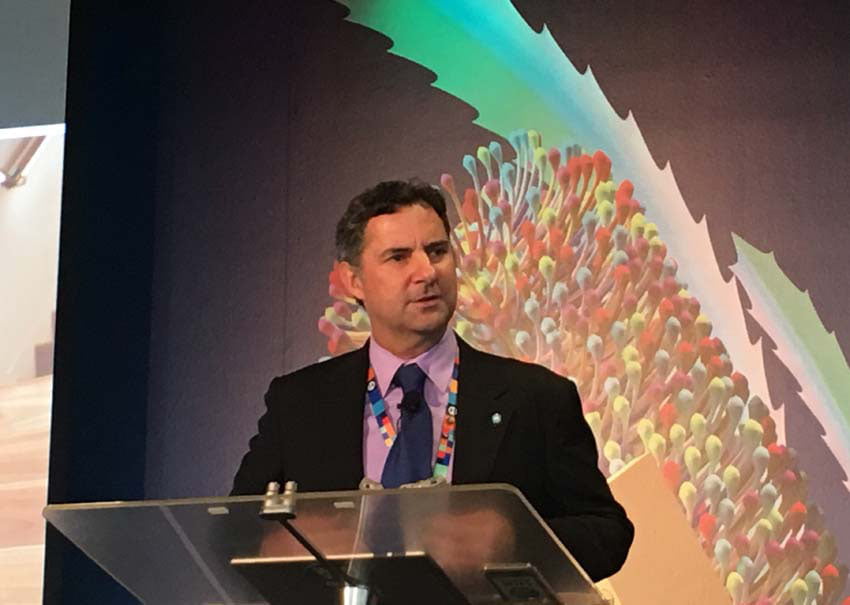‘C’ is for collaboration and commercialisation: two things Australia is miserably failing in, even though our science and research is top notch, according to the OECD. So, where are we going wrong?
According to CSIRO’s likeable chief executive Larry Marshall, Australia’s current collaboration and commercialisation levels can be blamed on the lack of alignment between scientists, universities, businesses, and government.
“We tend to scale like a flock of pigeons, rather than getting lined up with each other behind a really focused purpose,” he told InnovationAus.com.

That’s part of the reason why Dr Marshall is getting behind the “moonshot” idea of Australia becoming the “healthiest country on earth” – a national mission that was recommended by Innovation and Science Australia as part of 2030 Strategy.
“It really clearly defines what problems we’re trying to get our scientists to solve. I think that’s a great way to drive alignment with a purpose,” he said.
The blame can also be placed on the difficulty of getting startups to collaborate with scientists. The trouble there, according to Dr Marshall, is that science is considered not as plausible to invest in by venture capitalists in the same way as other non-science projects.
“If startups and scientists were to work together they can help make science investable. As brilliant as an idea is, you need to be able to put it into someone’s hand as some kind of product or prototype, and most of the time that’s where it falls down,” he said.
CSIRO has been attempting to address these issues as part of its Innovation Catalyst strategy vision since it was launched in 2015. Under the strategy, the national science agency has restructured into “market-facing business units”.
“If we put scientists into groups like agriculture and expose them to a lot of agricultural customers and challenges then quite naturally they will invent in agriculture,” Dr Marshall said.
“That clustering into relevant categories like agriculture, environment as opposed to having schools of science like physics and chemistry seems to make them more customer-centric,” he said.
The agency has also established a number of collaboration-focused programs, such as its Main Sequence Ventures, a $200 million fund designed to focus on investing in science, and its ON accelerator program aimed to help research teams commercialise their ideas.
It turns out these programs are helping to generate a “wonderful osmosis of knowledge exchange” between scientists and startups, says Dr Marshall.
“We’re a national science agency with big resources behind us, so you wouldn’t believe how many startups are working inside our building that we have brought in from outside,” he said.
“There’s this wonderful osmosis where a company wants to work on autonomous vehicles, so they need sensors, algorithms, vision systems, they need to understand social science, so sitting in the cafeteria of the CSIRO you meet all those people who can help.”
But creating programs and the right environment just sometimes is not enough. Dr Marshall said it’s also about shifting the mindset of scientists to think commercial.
“We’ve seen a culture change in 5,500 from CSIRO people. By opening up and letting the startups in, we change both cultures because they suddenly realise that science can help them, and scientists get really curious about the entrepreneurs and what they’re doing.
“We’ve had a number of startups volunteer to give us equity because we help them and they didn’t expect that.”
Dr Marshall also jumps to defend academia for the unfair criticism that they often get when it comes to not commercialising enough of their ideas.
“I don’t think commercialisation will ever be a significant funding stream for universities. We can just look at Stanford. The Dean of Research at Stanford told me they don’t do innovation, they do science.
“They can say this because while they’re one of the best in world, very little of their funding comes from innovation; 80 percent comes from education and the rest is endowment. So, I worry when we criticise universities,” he said.
He added it’s important that researchers have the freedom to go about their research. “I wouldn’t like us to get too prescriptive with universities for the reason some of the biggest breakthroughs happen in left field.”
As for what the “healthiest nation on earth” looks like to Dr Marshall?
It includes making a shift to the 11 million Australians who suffer from chronic diseases; improving Australia’s obesity rate, which currently sits in 6th place; and moving up Australia from 10th place in sustainable development goals.
“I do think the epiphany is the inter-connectedness. For CSIRO, we’re so strong in environment and environmental engineering, so I think that’s an untapped big lever on how we can improve our health. We’re seeing a big increase in pandemics, which is happening as a result of the changing environment.”
Do you know more? Contact James Riley via Email.

